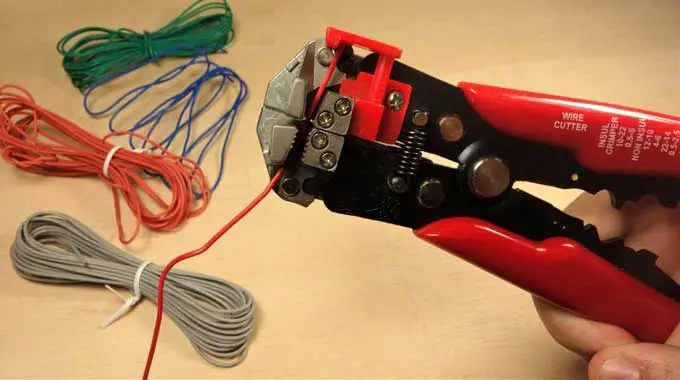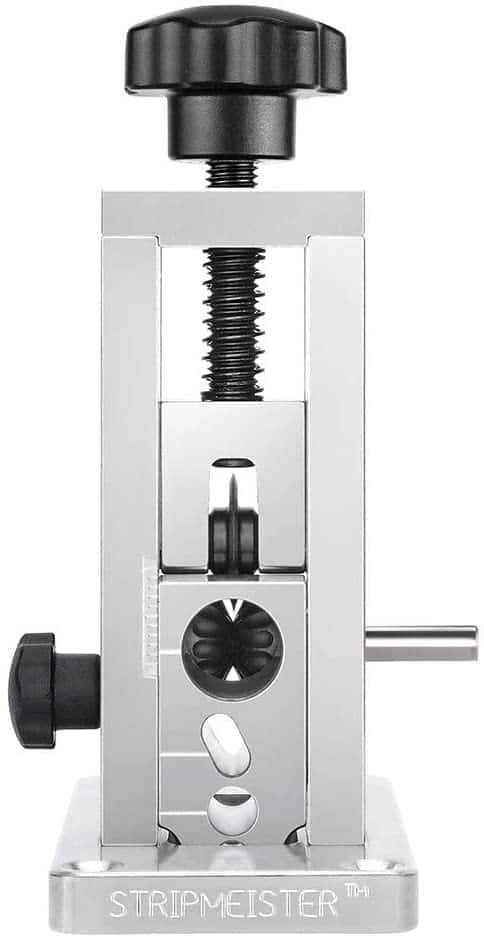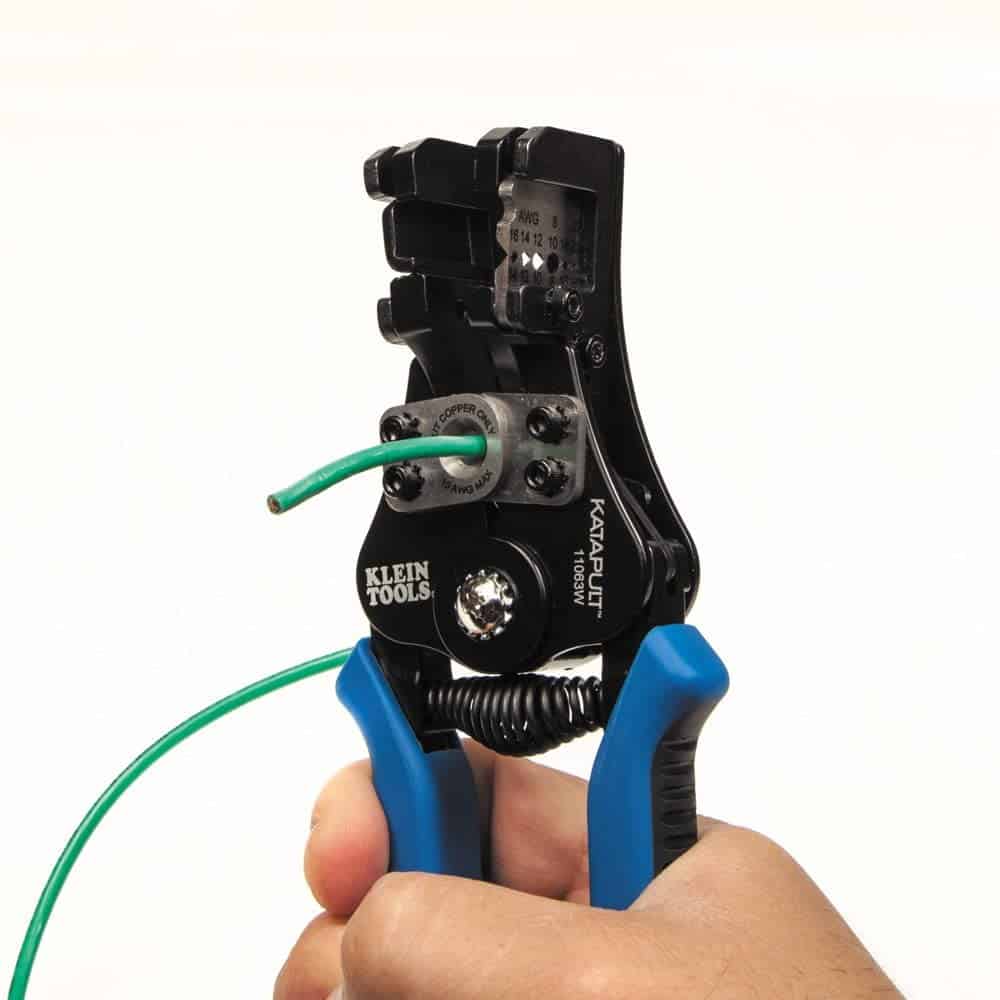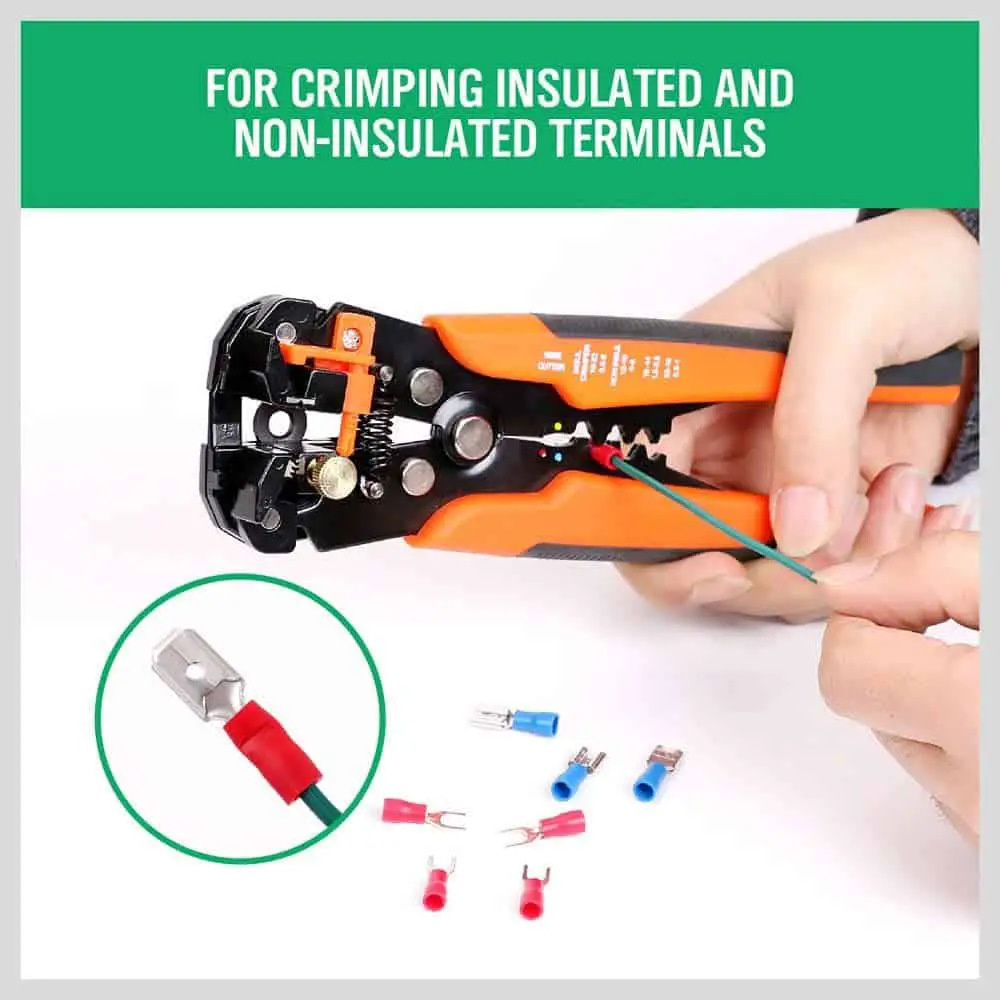The wires and cables are often insulated with a plastic or other non-heat or non-electrical conducting material. In order to use the wires, the insulation has to be stripped off.
Stripping wire fast is a bit tricky. There are a number of ways of stripping the insulation from the wires.
Some of the methods are fast whereas some are considerably slower. Some are more effective than others are.

The method you choose to strip your wires will depend on the wire length, size, and the number of wires you have to strip.
The method you choose will also be determined by the reason why you want to trip the wires in the first place. Whether it is for household use of resale.
The following are the options you have to strip your wires. The methods are discussed from the least effective to the most effective.
These are the fastest wire stripping tools out there, I’ll talk about more on these later in the post:
| Wire stripper | Images |
|---|---|
| StripMeister Automatic Wire Stripping Machine | 
|
| Klein Tools 11063 8-22 AWG Katapult Wire Stripper | 
|
| Most affordable wire stripper: Horusdy Stripping Tool | 
|
There are several reasons why you might need to strip wire, including rewiring old lamps, selling copper or stripping for scraps, installing a new doorbell, or even adding new outlets in the house.
Whatever the DIY, here’s how to do it.
In this post we'll cover:
- Nine Ways to Strip Wire Fast
- What is the best wire stripping tool?
- StripMeister Automatic Wire Stripping Machine
- Klein Tools 11063 8-22 AWG Katapult Wire Stripper
- Most affordable wire stripper: Horusdy Stripping Tool
- How do you strip wire by hand?
- How do you strip long wire?
- How do I strip copper wires fast?
- What is the fastest way to strip scrap wire?
- How do you strip very thin wires?
- Final Verdict
Nine Ways to Strip Wire Fast
Don’t worry, stripping wire is an easy skill to master and you can do it using specialty tools or manually with a variety of methods.
The sun warming method
You can only use this method when there is bright sunshine that is quite hot. This is only possible during the summer.
Since most insulation is made of plastic, putting the wires out in the hot sun could help soften the plastic. This makes it easier to pull it off.
Once the wire is hot and soft enough pull the insulation to strip off the wire. However, the method might not effective for thick cables and wires that are heavily insulated.
The sun warming method can be used alongside other methods such as cutting or with a manual wire stripper.
Boiling method
You will need the following items to strip wires using this heating method.
- A metal barrel
- Water
- Firewood
The first method you can use to remove plastic insulation from your cables is heating. To use the heating method you need a metallic barrel, water, and firewood.
- Boil the water in the barrel and dip the insulated wires in the boiling water. This should be done outdoors or open area.
- Let the wire sit in the boiling water for approximately 10 minutes or more.
- Remove the wire and pull it to slide off the insulation. You should do this as soon as you remove it from the water before it gets cold and stiff again.
Care should be taken not to burn or scald. The heating method is not very effective when scraping thicker wires. Furthermore, the boiling process may release fumes that are toxic and not good for your health.
You should not burn the insulated wires to get the cables. Burning plastic cables pollutes the environment. This could get you in trouble with the law. Burning also destroys the wires and reduces their quality.
The cutting method
These the items you will need for this method.
- Cutting blade
- Thick gloves
The knife or the cutting blade you choose should be very sharp. You should wear thick gloves to protect you from cuts and bruises from the cutting. This method can be reasonably used only if you have a few wires to strip.
This method is easy to apply and the materials are readily available. However, you can only strip a few cables at a time. It is quite slow.
The process of cutting to strip a wire off start with marking the point or length you want to strip. Then hold the knife or the cutting blade you have over the market spot. Press on it and turn the wire.
When you turn the wire, the cutting blade cut through the insulation. Be careful to press it a little bit light so as not to cut the wire inside. Once you see the wire, grip the end of the cable and pull the insulation off. You can grip it with pliers or hand.
Using a homemade tabletop wire stripper
Items you need are:
- Wooden board
- Pliers
- 2 Screws
- Cutting blade
- Gloves
There are many methods to make a tabletop wire stripper at home. This is one of the easiest to make. You can easily make this yourself at the garage using the items listed above.
Also read: Best electrician tool belts
The homemade stripper can come in handy when you have a couple of wires to strip. You can easily make this yourself at the garage using the items listed.
Using a manual wire stripper
This is one of the faster methods to strip wires and cables. Especially if you have many wires to strip. They are mainly tabletop but manual.
They do not use electricity. There are many wire strippers on the market and you can purchase one depending on your usage and budget.
The manual wire strippers are operated by hand using a hand-held motor and they are fixed with adjustable blades. The blades can be changed after some time if the initial ones become dull.
Using the electric wire stripper
Electric wire strippers are the best. They are most effective when you need to strip a great bulk of wires.
The electric wire strippers are a little more costly than the manual wire strippers are. They are a good investment if you want to strip wires for sale or for other commercial purposes. They are mostly used by scrap metal dealers but you can also purchase for home use.
You will need to read all the instructions on the machine before using it. It is effective for stripping all types and sizes of wires.
With a heat gun
This is a super fast and simple method of removing the insulation on the wire. First of all, put on a thick pair of gloves to avoid burning your hands and fingers.
Next, turn on the heater gun, and hold it close to the wire for at least 30 seconds. You will notice the wire starts to bend and the insulation begins melting slowly. Do not let the wire become black and burned as it’s not a good thing.
After about 30 seconds, use your hands to remove the insulation…it will simply come off easily and voila! You’ve stripped the wire in seconds.
With electrician’s scissors
Don’t attempt to use regular scissors, unless you are a professional and you are great at handling scissors. You risk cutting and injuring yourself with this method.
Instead, you should use electricians scissors, which are made specifically for electrical wires. They are thicker and not as sharp. What you have to do is rotate the scissors around the wire a few times. You’ll see that it starts to cut the coating off.
Then, using your hands and fingers, you can start to pull the insulation off in a few movements. Be careful not to nick the wire when you cut it with the scissors, you want to be gentle.
Using pliers
Everyone has pliers lying around the toolbox. That’s why this method is one of the easiest. For this technique, the secret lies in not squeezing the plier handle too hard, or you risk cutting the wire in half.
So, instead, grab the piece of wire with the plier jaws to hold it in place, but don’t squeeze hard. As you squeeze, rotate the wire inside the jaws continually.
At this point, as you rotate the wire, the blades will cut the insulation. Keep doing this until the plastic is weakened. Now, pull the sheathing off with your pliers. It might take some wriggling around with the sheathing until it slides off. This method is effective but it does take a bit longer.
What is the best wire stripping tool?
The tool known as a wire stripper is a small handheld tool that looks similar to pliers. However, it is used to remove the electrical insulation from electrical wires.
This type of tool is relatively inexpensive and it’s useful to have it around the house because you never know when you need to do some electrical work.
As well, you can use it to strip wires you want to use as scraps.
First of all, think about what type of tool you need and what you use it for.
If you need to do lots of wire stripping for a home renovation, for example, it’s best to invest in an industrial or commercial grade wire stripper.
These are automatic and make your work easier.
StripMeister Automatic Wire Stripping Machine

This type of automatic wire stripper is excellent if you want to bulk strip. It works for a whole range of wire thicknesses, which makes it super versatile.
As well, it works so well to strip Romex wire which is useful. In fact, Romex wire is the most popular type of wiring found in homes.
This tool works very quickly, so you can get more work done in a jiffy.
Here you can see it in use:
If you just need a manual wire stripper for small electrical tasks around the house or a quick DIY, we recommend a good manual handheld stripping tool.
Klein Tools 11063 8-22 AWG Katapult Wire Stripper

We recommend this particular wire stripping tool because it is easy to use. You only need to make a single hand motion and it strips the wire of its sheathing.
As well, it doesn’t damage the wire at all. It also removes up to 24 mm of insulation from the wires.
The best part is that is has a tension-grip mechanism which keeps the wire firmly in place. After it strips the wire, the spring recoils back to its original position.
Check prices and availability here
Most affordable wire stripper: Horusdy Stripping Tool
If you are a beginner or it’s your first time trying to strip wire, we recommend that you use a specialty tool called a wire stripper. We mentioned it above and it’s easy to use.
Here is another affordable option:

This type of manual wire stripping tool is fitted with a variety of notches that correspond to the different wire sizes or thicknesses.
You can use this tool for stripping, cutting, and crimping so it’s a handy tool to have around the home.
FAQ
How do you strip wire by hand?
Before you start stripping the wire, first identify the gauge of your wire by comparing it with the holes on the side of the tool.
Next, you place the tip of your wire at 1-1/2 inches from the end and right into the jaws of the tool. Make sure it is notched properly in the right sized gauge.
Then, close the wire stripper and make sure it is closed tight around the wire. This ensures it will cut through the wire’s sheathing.
Finally, when the jaws of the tool are still closed firmly, start pulling the sheathing off the end of the wire.
How do you strip long wire?
It’s best to use our #4 tip, the homemade wire stripper. This way you can easily pull the wire through the blade. As well, we recommend the electrical wire stripper if you have a lot of wires to strip as it’s a time saver.
How do I strip copper wires fast?
We recommend you use a box cutter to strip copper wires fast. Use gloves and simply pull the box cutter along the wire and it will cut the insulation right off. It’s like peeling the plastic off the wire. Use this method if you have a small amount of wire to strip, if you need to do lots, it will tire your hand and you risk cutting yourself.
What is the fastest way to strip scrap wire?
How do you strip very thin wires?
Final Verdict
As mentioned before the method you will choose to strip wires will depend on the size, length, and quantity of the wires. However, you can combine methods to strip wires fast.
I'm Joost Nusselder, the founder of Tools Doctor, content marketer, and dad. I love trying out new equipment, and together with my team I've been creating in-depth blog articles since 2016 to help loyal readers with tools & crafting tips.
